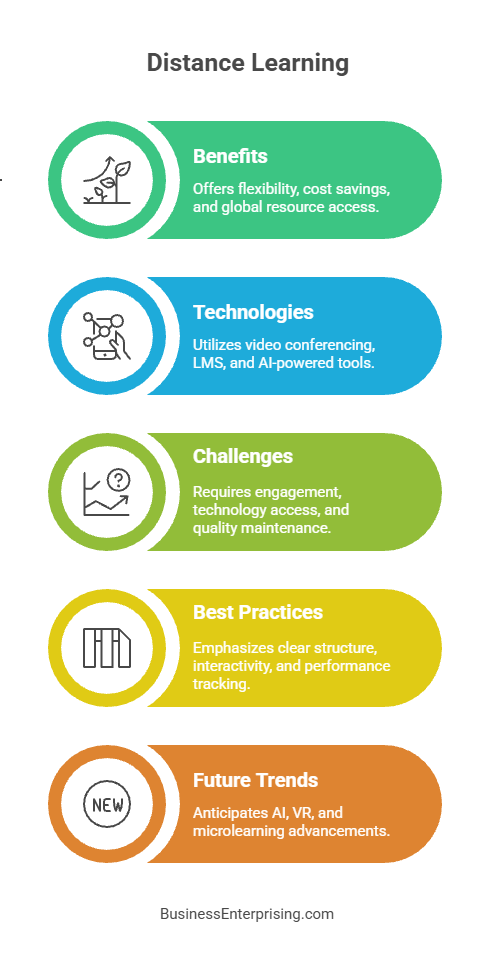
Additionally, the growth of online tools has made remote education more engaging and effective. Video conferencing, learning management systems, and collaborative platforms connect learners and instructors in real time. Furthermore, these technologies allow for interaction, feedback, and resource sharing that can closely match traditional classroom experiences. You can benefit from a wider range of programs tailored to your specific needs.
However, the appeal of distance learning is not limited to convenience alone. Businesses can use it to train teams across multiple locations with consistent quality. Therefore, organizations save both time and resources while maintaining high standards in employee development. Additionally, professionals gain access to courses and instructors they might not have locally, expanding their opportunities.
As the demand for flexible and scalable education continues to rise, distance learning will remain an important part of professional growth. By understanding its advantages and how it works, you can choose programs that align with your goals. Furthermore, staying aware of emerging tools and trends will help you make the most of what remote education has to offer.
Overview of Distance Learning in Business Education
Distance learning in business education refers to delivering courses and training through online platforms rather than in traditional classrooms. You can access learning materials, attend lectures, and complete assignments from almost anywhere with an internet connection. This flexibility allows you to continue your education without disrupting work or personal commitments. As technology improves, the quality and accessibility of distance learning have expanded significantly.
Many businesses now use distance learning to support professional growth. Therefore, employees can develop skills without taking extended time away from their roles. Additionally, organizations can train teams across multiple locations at the same time. This approach reduces travel costs and makes learning more consistent for everyone.
Furthermore, the growing availability of interactive tools has made online education more engaging. Live video sessions, discussion boards, and digital collaboration platforms allow you to connect with instructors and peers in real time. These connections help you apply concepts directly to your work. As a result, you can see benefits from training almost immediately.
Another reason for its growth is the increasing demand for flexible career development. Professionals often need to balance ongoing learning with busy schedules. Therefore, online programs designed for business education focus on practical skills that apply quickly in the workplace. Additionally, many offer self-paced modules so you can progress at a comfortable speed.
Distance learning continues to evolve, offering new opportunities for professional advancement. By embracing this format, you can expand your knowledge, improve your skills, and stay competitive in an ever-changing business environment.
Key Technologies Supporting Distance Learning
Technology plays a central role in making distance learning effective and accessible. Video conferencing tools allow you to join live classes, interact with instructors, and participate in discussions from anywhere. These platforms create real-time communication that closely matches the classroom experience. Therefore, they help maintain engagement and build stronger connections between participants.
Learning management systems organize course materials, assignments, and progress tracking in one place. Additionally, they give you access to recorded lectures, quizzes, and collaborative features. This structure supports consistent learning and makes it easier to stay on track. Furthermore, instructors can provide timely feedback, which helps you understand concepts more clearly and apply them effectively.
Other platforms also contribute to the success of remote education. For example, cloud-based collaboration tools allow you to share documents, work on projects, and communicate with classmates in real time. Therefore, group assignments become easier to manage, even when participants are in different locations. Additionally, interactive whiteboards and screen-sharing functions enhance the learning experience by making lessons more visual and dynamic.
AI-powered tools are also entering the space, offering personalized learning paths and automated assessments. These technologies can adapt to your performance and suggest targeted resources. Therefore, you can focus your efforts on areas needing improvement. As more tools integrate with each other, your experience becomes smoother and more efficient. The continued advancement of these technologies means distance learning will keep evolving. By understanding and using these tools, you can make your learning more productive, flexible, and connected to your goals.
Benefits of Distance Learning for Professionals and Businesses
Distance learning offers significant advantages for both professionals and businesses. You can study from anywhere without disrupting your work schedule. This flexibility allows you to balance learning with daily responsibilities. Therefore, you can continue building skills without pausing your career.
Cost savings are another clear benefit. Businesses can reduce travel expenses, venue costs, and printed materials by offering training online. Additionally, employees can avoid commuting, saving both time and money. These savings make training more accessible to a wider group of participants.
Scalability is also a strong advantage. You can deliver the same program to a small team or a large global workforce. Therefore, organizations can provide consistent training across locations. Additionally, updates to materials can be rolled out instantly, keeping information current for all learners.
Access to global resources expands your opportunities even further. Distance learning connects you with experts, instructors, and peers from around the world. This access allows you to gain insights from diverse perspectives and industries. Furthermore, you can build professional networks that extend far beyond your local area.
These benefits combine to make distance learning a practical and efficient choice for career development. By using flexible schedules, reducing costs, scaling programs, and tapping into global knowledge, you can create meaningful learning experiences. Additionally, these advantages can help businesses maintain a skilled and competitive workforce while meeting changing demands.
Challenges and Solutions in Distance Learning
Distance learning offers many benefits, but it also brings challenges that you need to address for effective results. Maintaining learner engagement can be difficult when participants are not physically in a classroom. Therefore, using interactive tools like live discussions, quizzes, and group projects can keep learners involved. Additionally, encouraging active participation helps maintain focus and improves retention.
Technology barriers are another common issue. Some learners may struggle with slow internet connections, outdated devices, or unfamiliar platforms. Therefore, providing clear setup instructions and offering basic technical support can reduce frustration. Additionally, selecting user-friendly platforms can help participants spend more time learning and less time troubleshooting.
Maintaining course quality is equally important. Online content must be clear, organized, and relevant to the learners’ goals. Therefore, regular updates and feedback collection can help identify areas for improvement. Additionally, incorporating real-world examples and case studies makes the material more relatable and easier to apply.
Furthermore, instructor presence plays a key role in course success. Prompt responses to questions and personalized feedback can make learners feel supported. Therefore, consistent communication should be a priority throughout the program. Additionally, tracking progress allows you to identify participants who may need extra help.
By addressing these challenges with practical solutions, you can improve the overall effectiveness of distance learning. When engagement is high, technology runs smoothly, and quality remains consistent, learners are more likely to achieve meaningful outcomes.
Best Practices for Effective Distance Learning Programs
Designing effective distance learning programs requires thoughtful planning and a focus on the learner experience. Clear course structure helps participants understand expectations from the start. Therefore, you should organize materials logically and provide a consistent format for lessons. Additionally, breaking content into manageable sections can prevent information overload and improve retention.
Interactivity is another essential factor. Live discussions, group projects, and interactive quizzes can keep participants engaged throughout the program. Therefore, you should encourage active participation to make the learning process collaborative. Additionally, incorporating multimedia elements such as videos and visual aids can help explain complex topics more effectively. These strategies make the experience more dynamic and relatable.
Performance tracking allows you to measure progress and identify areas for improvement. Regular assessments, feedback forms, and progress reports give valuable insight into how well learners are meeting objectives. Therefore, you can adjust content or pacing to better support participants. Additionally, sharing feedback with learners can motivate them and help maintain momentum.
Furthermore, instructor involvement can strengthen learning outcomes. Prompt responses to questions and consistent communication help create a supportive environment. Therefore, you should schedule regular check-ins to maintain engagement and address any issues early. Additionally, recognizing achievements can boost morale and encourage continued participation.
By combining structured design, interactive elements, and effective tracking, you can create distance learning programs that deliver measurable results. This approach supports both learner success and long-term program effectiveness.
Future Trends in Distance Learning for Business
The future of distance learning for business will be shaped by advanced technologies that make training more personalized, immersive, and efficient. AI will play a central role by analyzing learner performance and adapting content to individual needs. Therefore, you can expect courses that adjust in real time to your progress. Additionally, AI can automate assessments, freeing instructors to focus on deeper engagement.
Virtual reality will create interactive environments where learners can practice skills in realistic scenarios. This approach is especially valuable for industries that require hands-on experience. Therefore, you can train employees in complex tasks without physical risks or high costs. Additionally, virtual simulations can make learning more memorable by immersing participants in dynamic settings.
Microlearning will also become more common. Short, focused lessons fit easily into busy schedules and reinforce knowledge over time. Therefore, businesses can provide continuous training without disrupting daily operations. Additionally, mobile platforms will make these modules accessible anywhere, giving learners more control over when and how they engage.
Other innovations include integrated analytics tools that track performance across multiple programs. These systems allow you to measure the impact of training and adjust strategies quickly. Furthermore, collaboration platforms will continue to evolve, making it easier for remote teams to share ideas and work together on projects.
By combining AI, virtual reality, microlearning, and other tools, the future of distance learning will offer flexible, measurable, and highly engaging training experiences. This shift will help businesses strengthen skills, improve productivity, and adapt to changing demands.
Conclusion
Distance learning has become an important tool for professional growth and business development. You can now access quality education without being tied to a physical location. This flexibility allows you to balance training with work responsibilities while maintaining productivity. Therefore, it offers clear advantages for both individuals and organizations.
Additionally, the variety of available technologies makes learning more engaging and accessible. Video conferencing, learning management systems, and collaboration tools connect you with instructors and peers anywhere in the world. Furthermore, these tools allow for real-time feedback and personalized support, which can improve both learning outcomes and satisfaction.
However, the success of distance learning depends on thoughtful design and active participation. Interactive elements, relevant content, and consistent performance tracking all contribute to meaningful results. Therefore, you should select programs that fit your goals and learning style. Additionally, ongoing evaluation can help you refine your approach and gain the most value from each course.
Looking ahead, innovations like AI, virtual reality, and microlearning will continue to shape online education. These advancements will offer more personalized, immersive, and flexible options for professional development. Therefore, staying informed about these changes will help you choose solutions that align with your needs. By using distance learning strategically, you can build skills, expand knowledge, and strengthen your ability to meet new challenges in your career.



